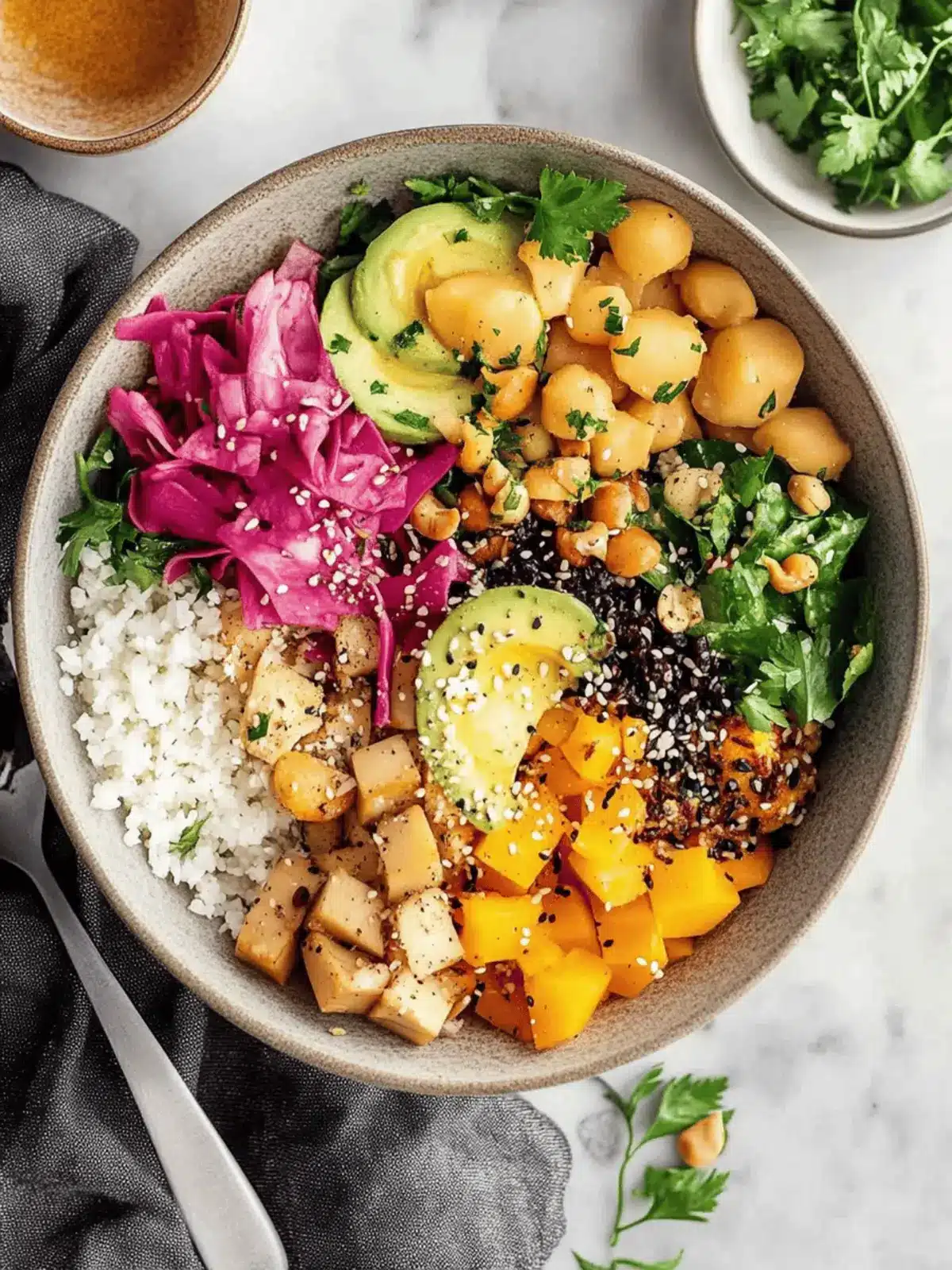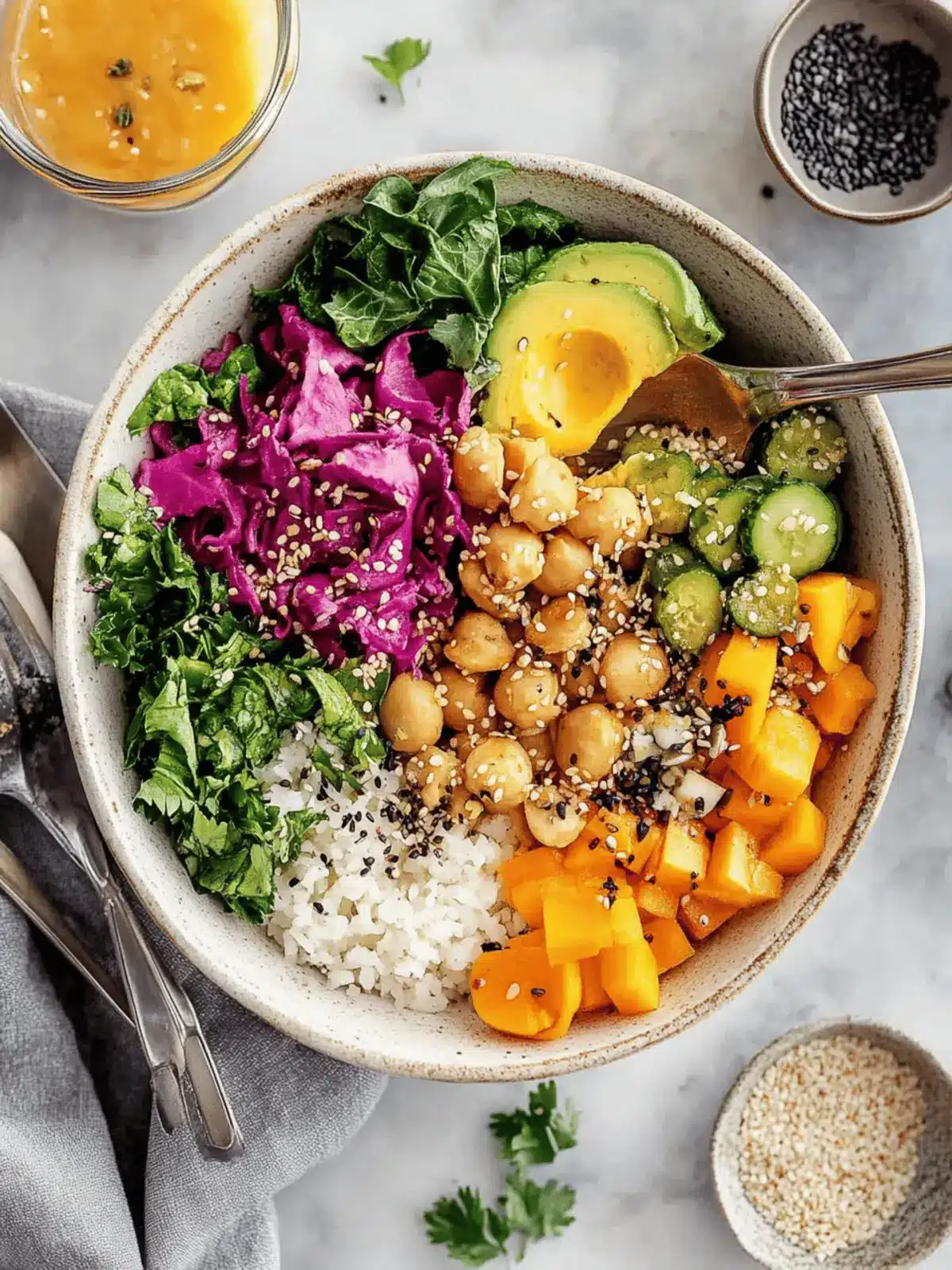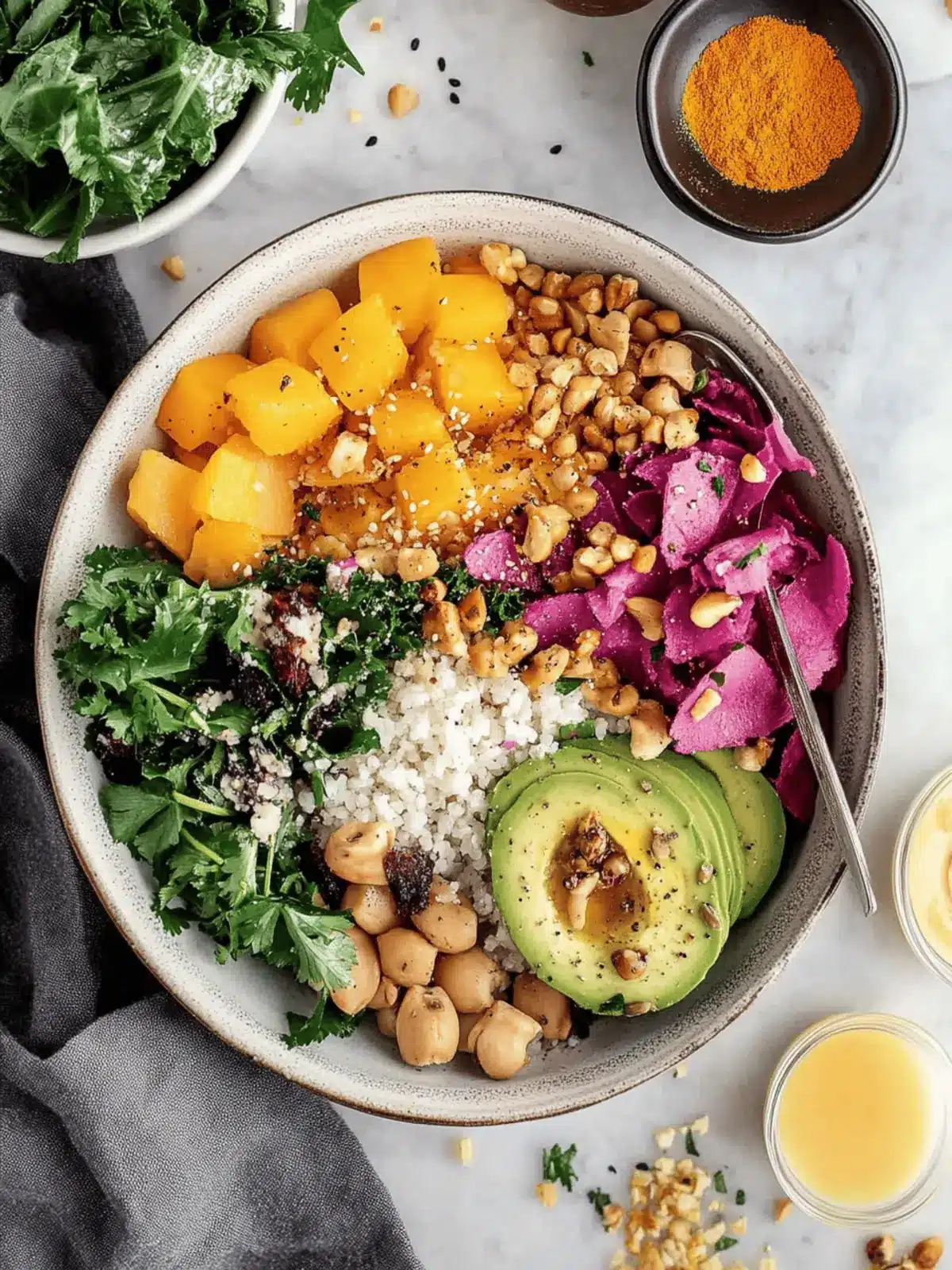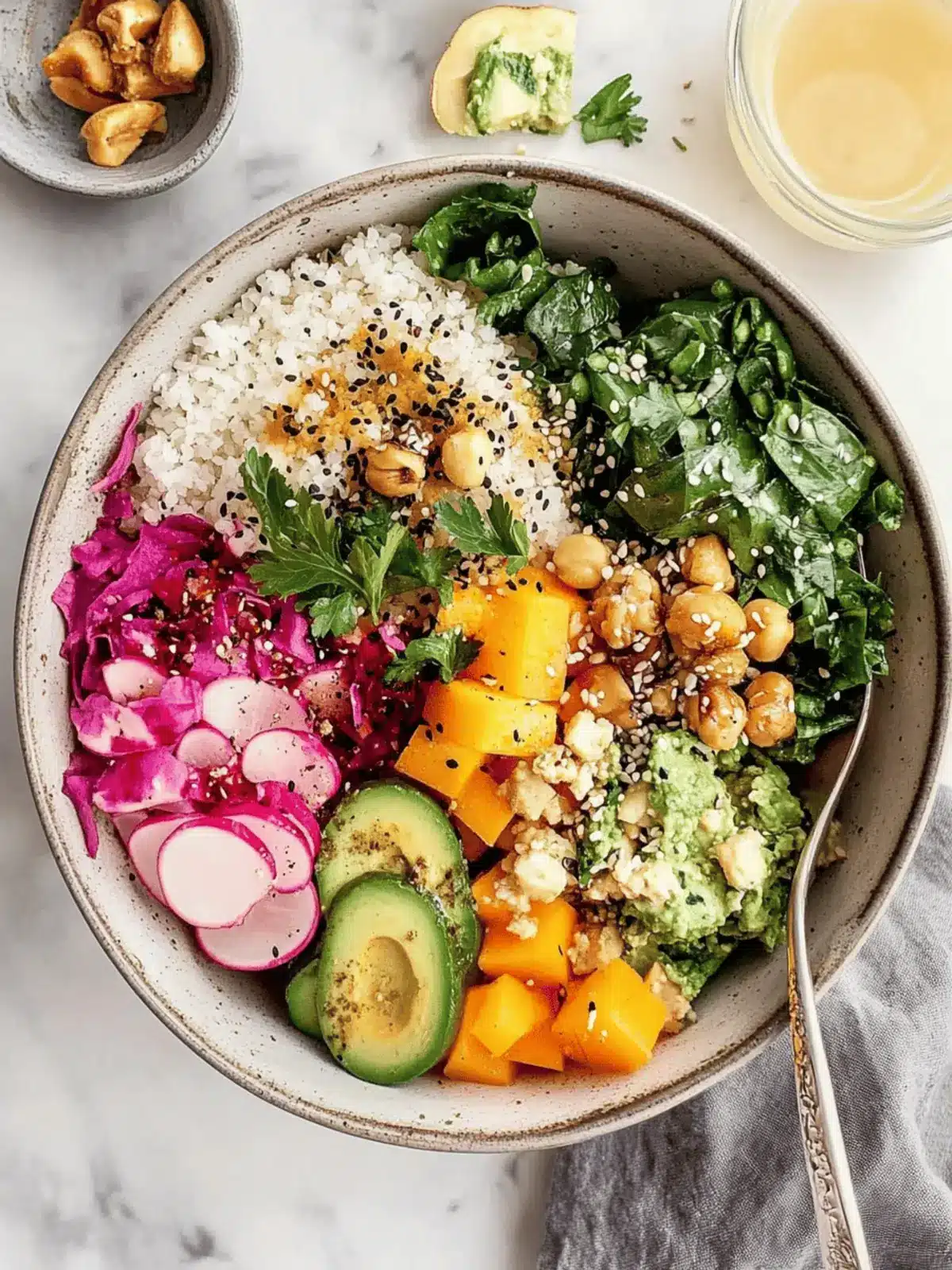Picture this: the sun is shining, and you’re in your kitchen, the air filled with the delightful aroma of roasted sweet potatoes and vibrant herbs. That’s exactly the feeling I had when I first assembled my Ultimate Vegan Buddha Bowl. This dish is not just a meal; it’s a colorful celebration on a plate, perfect for those busy weeknights or as a staple during your meal prep routine. With an assortment of fresh vegetables, hearty grains, and a creamy turmeric tahini sauce, it invites you to explore a world of flavor and nutrition. What’s more, it’s endlessly customizable! Whether you prefer quinoa or brown rice, chickpeas or lentils, this bowl adapts to your tastes, allowing you to mix and match while keeping things exciting in your kitchen. And I promise, every bite will leave you feeling nourished and satisfied. Ready to dive into this wholesome adventure? Let’s create the best Buddha bowl together!
Why is this the best Buddha bowl recipe?
Colorful, nutritious ingredients make this bowl a feast for the senses. Endlessly customizable, you can easily switch up grains or proteins according to your preferences. Meal prep friendly, it allows for a stress-free week of healthy eating. Vibrant flavors, from tangy turmeric tahini sauce to sweet roasted potatoes, keep every bite exciting. Plus, it’s a fun and creative way to include more veggies in your diet! Don’t forget to check out our other meal prep recipes for more delicious ideas!
Best Buddha Bowl Ingredients
Discover how to create a colorful and delicious best Buddha bowl that will inspire your culinary creativity!
For the Base
- Cooked Brown Rice/Quinoa – This hearty base adds a comforting texture and is rich in fiber; swap with farro or barley for a twist.
- Cooked Chickpeas/Lentils – Packed with protein and fiber, they keep the bowl satisfying; black beans can also be a great substitute.
For the Roasted Veggies
- Sweet Potato – Provides natural sweetness and a creamy texture when roasted; butternut squash or pumpkin works well as a delicious alternative.
- Medium Carrots – Bring a wonderful sweetness and crunch; consider using baby carrots or shredded for ease of prep.
- Watermelon Radish/Red Radishes – Add a crunchy bite and mild zing; turnips can serve as a similar textural swap.
For the Greens
- Kale – Offers nutrients and a chewy texture; feel free to replace it with softer spinach for a different experience.
- Shredded Red Cabbage – A colorful, crisp addition; if unavailable, green cabbage can provide a nice crunch too.
For the Dressing
- Turmeric Tahini Sauce – This creamy, zesty sauce brings the dish together; plain tahini can be enhanced with spices if you’re out of turmeric.
For Topping
- Microgreens (optional) – These little gems elevate appearance and nutrition; sprouts or fresh herbs make excellent alternatives.
- Sesame Seeds/Hemp Seeds – Sprinkle these for added crunch and nutty flavor; sunflower seeds or pumpkin seeds also add delightful texture.
- Sea Salt & Pepper – Essential for seasoning; adjust to your taste to enhance all the delicious flavors.
With these ingredients, you are well on your way to creating the best Buddha bowl, uniquely tailored to fit your tastes and nutritional needs! Enjoy the colorful journey to health and flavor.
How to Make the Best Buddha Bowl
-
Preheat the oven to 400°F (200°C) and line a baking sheet with parchment paper for easy cleanup. This ensures your sweet potatoes roast beautifully and don’t stick!
-
Toss cubed sweet potatoes with olive oil, salt, and pepper, and spread them evenly on the baking sheet. Roast for about 20 minutes until they turn golden brown and tender.
-
Prepare the radishes and carrots by slicing the radish thinly and peeling the carrots into vibrant ribbons. Toss them with a squeeze of lemon and set them aside for a fresh, zesty bite.
-
Massage the kale with a squeeze of lemon and a pinch of salt until softened. This enhances the texture, making it delightful to eat.
-
Assemble the bowls by layering the cooked brown rice or quinoa as the base, followed by chickpeas, kale, carrots, radishes, shredded cabbage, sweet potatoes, and sauerkraut. Top with sesame seeds and microgreens for added flavor and nutrition!
-
Serve your vibrant Buddha bowls immediately, drizzling generously with the creamy turmeric tahini sauce to elevate the flavors.
Optional: Garnish with fresh herbs for an extra pop of flavor!
Exact quantities are listed in the recipe card below.

What to Serve with Ultimate Vegan Buddha Bowl?
Elevate your vibrant meal with delightful sides that complement every bite of this colorful dish.
- Crispy Brussels Sprouts: Roasted until caramelized, these add a lovely crunch and earthy flavor. They are a great contrast to the creamy tahini sauce.
- Grilled Asparagus: Lightly charred, this vegetable brings a fresh, slightly smoky flavor that balances the bowl’s richness. Perfect for springtime meals!
- Avocado Toast: Creamy and satisfying, avocado toast provides healthy fats that round out the meal, pairing beautifully with the zesty punch of the bowl.
- Quinoa Salad: Tossed with citrusy dressing, this salad offers a refreshing crunch and is a delightful way to incorporate more vegetables into your meal.
- Chia Seed Pudding: For dessert, this creamy treat is rich in nutrients and offers a gentle, sweet end to your meal, harmonizing with the bowl’s healthful nature.
- Lemonade or Iced Herbal Tea: Both beverages refresh the palate with bright flavors and lightness, providing hydration and zest that playfully enhance the dish’s taste.
These pairings will create a wholesome dining experience, making your ultimate vegan Buddha bowl the star of the table!
How to Store and Freeze the Best Buddha Bowl
- Fridge: Store individual components separately in airtight containers for up to 4 days. This retains freshness and flavor, allowing you to enjoy your best Buddha bowl throughout the week.
- Freezer: Freeze roasted sweet potatoes, cooked grains, and chickpeas in airtight bags for up to 3 months. Just remember to thaw them overnight in the fridge before assembly!
- Reheating: To reheat, use a microwave or oven until heated through. If the kale seems wilted after storage, a quick massage with lemon can refresh its texture.
- Meal Prep: For meal prep, keep all ingredients in separate bags or containers so you can mix and match each day. This way, you’ll have a delicious and nutritious Buddha bowl ready whenever hunger strikes!
Make Ahead Options
These Ultimate Vegan Buddha Bowls are perfect for busy home cooks who crave healthy meals without the last-minute stress! You can roast the sweet potatoes and prepare the turmeric tahini sauce up to 3 days in advance, storing them in airtight containers in the fridge for optimal freshness. Additionally, you can chop the veggies—like kale, radishes, and carrots—up to 24 hours ahead; just keep them refrigerated in separate containers to maintain their crispness. When ready to serve, simply combine the prepped ingredients with the cooked grains and chickpeas, then drizzle the sauce on top for a delightful meal that is just as nourishing and delicious as when freshly made.
Expert Tips for the Best Buddha Bowl
- Kale Massage: Ensure you massage the kale with lemon and salt until it’s wilted but still vibrant; this improves the flavor and chewiness immensely.
- Roasting Sweet Potatoes: Check on your sweet potatoes halfway through roasting to avoid burning. They should be golden and tender but not overly charred.
- Cool Ingredients: Allow roasted veggies to cool slightly before assembling the bowl; this helps maintain texture in your best Buddha bowl.
- Separate Storage: If meal prepping, store ingredients separately in airtight containers to keep everything fresh until you’re ready to enjoy your bowl.
- Dress It Up: Don’t hesitate to experiment with different dressings; a tangy lemon vinaigrette or spicy peanut sauce can lead to delightful surprises for your Buddha bowl!
Best Buddha Bowl Variations & Substitutions
Feel free to mix and match ingredients to create your perfect bowl of bliss!
-
Gluten-Free Grains: Swap quinoa or brown rice with gluten-free grains like millet or buckwheat for a satisfying base.
-
Protein Power: Use edamame or tofu in place of chickpeas or lentils to add a delightful plant-based protein twist that’s equally filling.
-
Earthy Beets: Replace sweet potatoes with roasted beets for a beautifully vibrant color and an earthy, sweet flavor that pairs well with tahini.
-
Colorful Bell Peppers: Mix in sliced bell peppers for an added crunch and a pop of sweetness; they bring freshness to every bite!
-
Creamy Avocado: Top your Buddha bowl with slices of creamy avocado for extra richness and healthy fats that enhance the dish’s nutrition.
-
Spicy Kick: Add sliced jalapeños or a drizzle of sriracha to spice things up! A little heat can elevate the flavors and bring excitement to your bowl.
-
Herb Infusion: Experiment with fresh herbs such as cilantro or mint in place of microgreens for a fragrant and fresh touch that brightens the bowl.
-
Nuts for Crunch: Toss in a handful of toasted almonds or walnuts for a delightful crunch and additional nutty flavor that perfectly complements the creamy sauce.
Feel free to explore and make your best Buddha bowl uniquely yours! Each variation opens up a new world of taste and texture, inviting you on a delicious culinary adventure.

Best Buddha Bowl Recipe FAQs
What vegetables should I use for my Buddha bowl?
You can use a variety of vegetables! I recommend sweet potatoes for their creaminess, but you can also try roasted zucchini or bell peppers for different flavors. Just remember to ensure they’re fresh and vibrant; avoid any ones with dark spots or signs of spoilage.
How long will my Buddha bowl components last in the fridge?
Stored in airtight containers, your Buddha bowl components can last up to 4 days in the fridge. Make sure to keep the grains, veggies, and dressing stored separately to maintain their freshness and texture—this way, you’ll enjoy each dish as if it were freshly made!
Can I freeze the ingredients of my Buddha bowl?
Absolutely! You can freeze roasted sweet potatoes, cooked grains, and chickpeas in airtight bags for up to 3 months. When you’re ready to use them, thaw overnight in the refrigerator. To reheat, just pop them in the microwave or oven until they’re heated through and ready to enjoy!
What if my kale turns out tough or bitter?
If your kale feels tough or bitter, don’t worry! Make sure to massage it well with lemon juice and salt. Just squeeze some lemon over the chopped kale, sprinkle a little salt, and then using your hands, gently massage it until it softens. This should make it more pleasant to eat, enhancing the flavor and texture for your best Buddha bowl!
Are there any allergy considerations I should keep in mind?
Yes, it’s important to consider allergies! If you’re cooking for someone with a sesame allergy, you can substitute the tahini in the dressing with sunflower seed butter or omit it altogether. Always double-check with your guests about any specific dietary restrictions or allergies before serving your delicious Buddha bowl!

Best Buddha Bowl Recipe for Ultimate Plant-Powered Bliss
Ingredients
Equipment
Method
- Preheat the oven to 400°F (200°C) and line a baking sheet with parchment paper for easy cleanup.
- Toss cubed sweet potatoes with olive oil, salt, and pepper, and spread them evenly on the baking sheet. Roast for about 20 minutes until they turn golden brown and tender.
- Prepare the radishes and carrots by slicing the radish thinly and peeling the carrots into vibrant ribbons. Toss them with a squeeze of lemon and set aside.
- Massage the kale with a squeeze of lemon and a pinch of salt until softened.
- Assemble the bowls by layering the cooked brown rice or quinoa at the base, followed by chickpeas, kale, carrots, radishes, shredded cabbage, and sweet potatoes. Top with sesame seeds and microgreens.
- Serve your Buddha bowls immediately, drizzling generously with turmeric tahini sauce.






